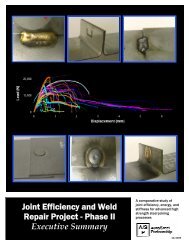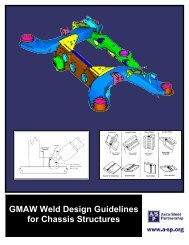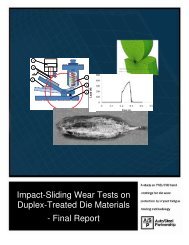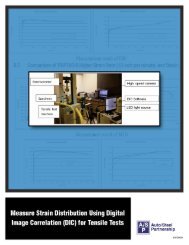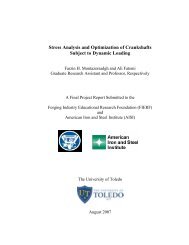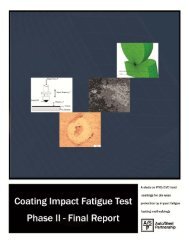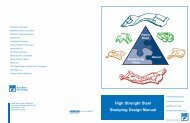Light Truck Frame Joint Stiffness Study Phase 1 Final Report
Light Truck Frame Joint Stiffness Study Phase 1 Final Report
Light Truck Frame Joint Stiffness Study Phase 1 Final Report
Create successful ePaper yourself
Turn your PDF publications into a flip-book with our unique Google optimized e-Paper software.
JOINT STIFFNESS TOOLBOX<br />
Introduction<br />
A design experiment was run using the Altair <strong>Study</strong>Wizard. These experiments included consideration of<br />
the linearity of the joint parameters and the interactions between them on the joint stiffness. The<br />
mathematical response of each joint was programmed into an Excel spreadsheet. Designers and<br />
engineers will be able to enter joint dimensions, thickness, and any discrete variables simulated in the<br />
DOE, and obtain calculated joint stiffnesses. The Excel spreadsheet allows the user to input any joint<br />
definition that is within the DOE experiment range.<br />
The spreadsheets also contain Design Rules and Observations to be considered when making design<br />
decisions. The Design Rules were created from finite element and sensitivity analysis data to help make<br />
stiffer joints. For example, in the case of <strong>Joint</strong>s 1 and 3, where the crossmember is a round section, the<br />
design rules included two points: making the tube diameter as large as possible, and making the tube<br />
thickness as thick as large as possible. The <strong>Joint</strong> Observations contained information regarding joint<br />
deflection and welding information stemming from the analytical results.<br />
An example overview of the spreadsheet is shown in Figure 31. The spreadsheet for each of the joints is<br />
shown in Figures 32 through 41 with two figures for each joint; the first figure shows the input and<br />
calculated results for the joint stiffness, and the second figure shows the joint observations, notes and<br />
design rules.<br />
<strong>Joint</strong> #1: Tube Through Tube<br />
<strong>Stiffness</strong> Calculations<br />
Input (mm)<br />
Test Design Window<br />
Design Variables (mm) Case 1 Case 2 <strong>Joint</strong> Min (mm) Max (mm)<br />
Thickness<br />
Crossmember 2.5 2.5 2.5 2 6<br />
Side Rail 2.8 2.8 2.8 2 6<br />
Shape<br />
Animations Shape Variables (mm)<br />
animations\JCrossmember Diameter 57 57 57 50 100<br />
animations\JSide Rail Height 125 125 125 75 150<br />
animations\JSide Rail Width 125 125 125 75 150<br />
Output<br />
Loading<br />
Animations <strong>Stiffness</strong> Calculations Case 1 Case 2<br />
Test<br />
<strong>Joint</strong><br />
Units<br />
animations\JKx Bending <strong>Stiffness</strong> (Mx) 3.235 3.235 3.477 kN-m/deg<br />
animations\JKy Torsion <strong>Stiffness</strong> (My) 3.271 3.271 12.715 kN-m/deg<br />
animations\JKz Fore/Aft <strong>Stiffness</strong> (Mz) 3.507 3.507 3.662 kN-m/deg<br />
Illustration Key:<br />
A = Side Rail<br />
B = Crossmember<br />
Design Rules:<br />
* Make the crossmember diameter as<br />
large as possible.<br />
* Make the crossmember as thick as<br />
possible.<br />
* Thickness and diameter of the<br />
crossmember should be increased<br />
together if possible.<br />
<strong>Joint</strong> Observations:<br />
* The crossmember is the most<br />
important part of this joint. The thickness<br />
of the crossmember is 3X more sensitive<br />
than the thickness of the side rail.<br />
* The maximum stress is in the<br />
crossmember at the connection to the<br />
inner side rail for all 3 <strong>Stiffness</strong> Cases.<br />
* The outer weld (the crossmember to<br />
outer side rail) could be a partial weld<br />
because this section of the joint has low<br />
stress.<br />
Notes:<br />
* Modify the input values (yellow) based on<br />
your design criteria. There are two columns<br />
in which in to input and evaluate data, case 1<br />
and case 2. The calculated stiffness will be<br />
displayed in red.<br />
* Design variables are listed in order of<br />
influence on stiffness.<br />
* Click on the animation to the left of the<br />
variables and loading conditions to see an<br />
animation of respective shape variable or<br />
loading condition.<br />
* The mass calculation is based on 150 mm<br />
extension of joint members from the side rail<br />
to crossmember interface. (The crossmember<br />
is 150mm from the joint interface to the end of<br />
the crossmember). This caluclation is to serve<br />
as a reference, not the absolute value.<br />
* The password to unprotect cells in this<br />
spreadsheet is: steel.<br />
Mass 4.801 4.801 4.801 kg<br />
Yellow cells are user input data.<br />
Red cells are calculated numbers.<br />
Figure 31: Example of the <strong>Joint</strong> <strong>Stiffness</strong> Toolbox Spreadsheet<br />
<strong>Report</strong>: A/SP-005-1 <strong>Light</strong> <strong>Truck</strong> <strong>Frame</strong> <strong>Joint</strong> <strong>Stiffness</strong> <strong>Study</strong> 58



